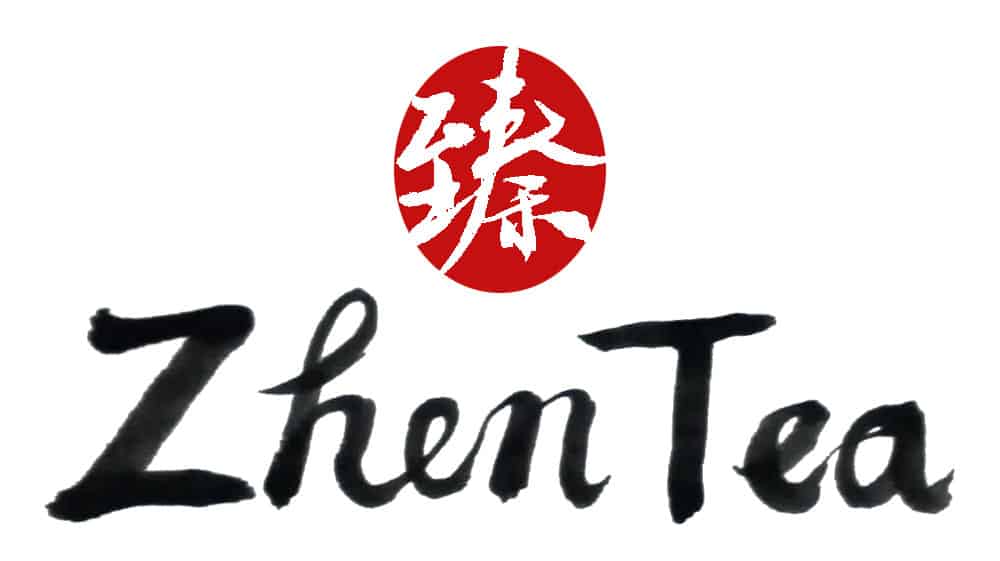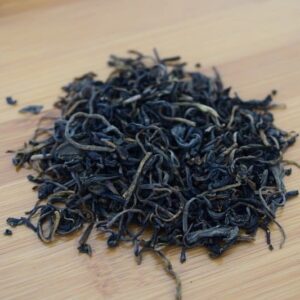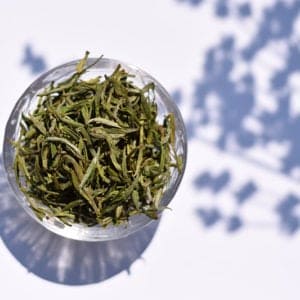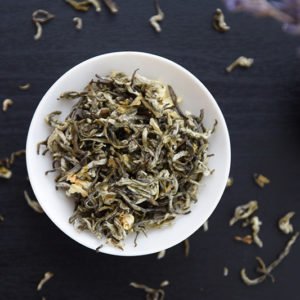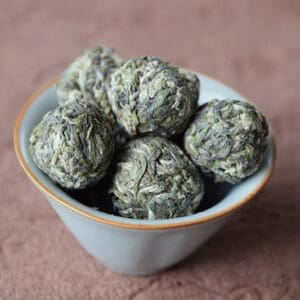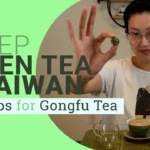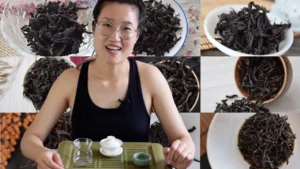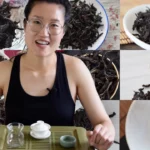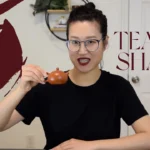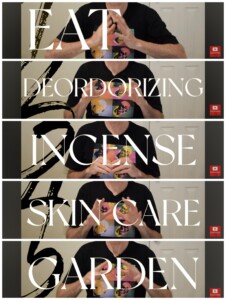Xihu Long Jing
Among tea, Xihu Long Jing is probably the first to come to mind for many people. Emperor Qian Long went to Jiangnan 6 times during his lifetime. On his 4th visit, he went to the Long Jing tea region to see tea plucking and production, to taste tea and write poems. He also designated the 18 tea bushes as royal tea bushes, in person. These bushes were located in front of Hu Gong Temple at the foot of Shifeng Mountain in Hangzhou, making Hangzhou Shifeng Mountain the center of attention. This blessed mountainous area becomes the destination for the people afterwards.
SIP ALONG with
Ming Qian Not Long Jing
$8.00 – $29.00
Dry Leaf: Sweet, light nutty
Liquor Colour: Sparkling green
Liquor Aroma: Sweet pea
Flavor: Sweet snap pea, hints of nuttiness
Mouthfeel: Clean and mouth-watering
Gaiwan Lid: Pea flowers
-
Description
Presenting the exquisite Ming Qian Not Long Jing, a tea that, despite its playful name and unique origin in Guizhou, rivals Ming Qian Long Jing from Zhejiang and provides exceptional value. This tea captivates with a brilliant and enduring flavor, making it the envy of many Long Jing varieties.
From the moment you inhale the dry leaf’s aroma, the sweetness of snap peas beckons, creating a delightful experience from start to finish. The liquor, an enchanting shade of green, shimmers with tea fuzz, teeming with antioxidants and natural sweetness. What sets it apart is its absence of bitterness, replaced by a refreshing soy nutty sweetness that lingers on the palate long after each sip.
Ming Qian Not Long Jing isn’t just about exceptional flavor; it’s a testament to lingering power, wrapped in a clean, mouthwatering mouthfeel. Savor the distinctive character of this unique and enticing tea that defies expectations and provides great value, especially when compared to its big brother from Zhejiang!
-
Additional information
Origin Meitan, Guizhou Province.
Harvest March 24, 2020.
Brewing 3g/150ml at 95°C for 1 ½ min. 3 – 4 infusions.
Storage Sealed well. Keep refrigerated.
You may also like…
-
Huang Da Cha
$8.00 – $28.00 -
Da Ye Qing
$8.00 – $29.00 -
Guzhu Zi Sun – Ming Qian
$31.00 – $120.00
Long Jing tea, Long Jing spring
Long Jing, is a tea name. It is also the name of a well, a village, and an area. After Emperor Qian Long visited Long Jing for tea (Long Jing wen cha), not only the tea itself but the whole region became much more valued by people.
When considering Long Jing tea quality, the earlier the better has always been of prime importance, especially when plucked before Qing Ming which is also known as ming qian cha. The perfect plucking is focused on the tenderness of the complete leaves and buds. A one bud pluck is call lian xin (lotus seed’s heart); a one bud one leaf pluck looks like a flag (the leaf) on a spear (the bud) and is called qi qiang (flag and spear); one bud with two newly opened leaves, looks like a sparrow tongue and is called que she (sparrow’s tongue).
Appreciation before drinking
Long Jing dry leaves are flat with tender leaves. The color and shape is uniform with a similar width, a yellowish-green color, and a smooth texture. One bud with one or two leaves, with the bud being longer than the leaves and under 3 cm. There should be no stems or broken pieces. Long Jing has a beautiful aroma while the counterfeit ones smell mostly grassy with many stems and rough texture.
Enjoy sipping
The liquor of Long Jing is yellowish-green and bright. The taste is rich, refreshing, and brisk. The luxuriant aroma is very relaxing, refreshing, deep, and complex, but not strong. When sipping and tasting, it’s nourishing to the mouth and throat and the fragrance lingers.
-
Ming Qian Dafo Long Jing
$32.00 – $118.00
The legend of qu zhi dai gui
When serving tea to a guest, the guest slightly bends the right hand’s index finger and middle finger and gently knocks on the table a couple of times to express gratitude. This is a special form of manners (xie cha li) in tea, also known as qu zhi dai gui (bend fingers instead of kneeling).
The legend is:
When Emperor Qian Long visited Jiangnan area, he dressed up as a servant. When the group arrived at a tea house for a tea break, the owner gave the teapot to Emperor Qian Long, and asked him to serve tea to his supposed master who was actually Qian Long’s eunuch. Qian Long felt it was fun for a change and did it, but the eunuch was extremely frightened but couldn’t even kneel to thank the emperor for such an honor because it would expose the emperor’s real identity. At this moment he thought of using his finger knuckles to mimic kneeling and bent them as if kneeling, knocking gently on the table. Gradually, this manner became popular among people.
Nowadays, whether it’s a senior or a superior, or just among peers, using the first two fingers knuckles to knock on the table is an oft used tea manner that expresses appreciation. Sometimes it’s not even the knuckles but simply the first two fingers gently tap on the table twice. It’s both intimate and courteous.
-
Aged Tian Jian
$14.00 – $52.00 -
Guzhu Zi Sun – Ming Qian
$31.00 – $120.00
Bi Luo Chun
After Long Jing, the second most famous tea is probably Bi Luo Chun. The Dongting Mountains, located in originally Wu county, Suzhou, has two mountains, west, and east. West Mountain is considered to produce the best Bi Luo Chun. Like Long Jing, this tea also comes from Jiangnan. The universe really favors this region giving it an unparalleled environment. These teas, because of the long history and culture around them, have a value that surpasses the tea itself, making it hard to find real ones and expensive if found.
Beautiful names
Bi Luo Chun is famous for its “beautiful shape, rich color, unreserved aroma, and complex taste.” Its reputation is mostly thanks to Emperor Kang Xi. Before he renamed Bi Luo Chun, it was called “scarily aromatic” by the locals. When the emperor visited Dongting in Jiangnan, he tried this tea and fell in love right away. After hearing the crude name of the tea, he decided it needed an upgrade. Because the tea came from Biluo Mountain, and was shaped like a snail and plucked in the early spring, he renamed it Bi Luo Chun (Green, Snail, Spring). Bi Luo Chun became a royal tea for the Qing Dynasty, subsequently becoming famous all around the country.
Appreciation before tasting
Characteristics of dry leaves:
Bi Luo Chun has a uniform, slim shape, is curly like a snail shell, covered in silver tea fuzz and green in color, with a light, pleasant aroma. The earlier the pluck, the more silver fuzz, and the more tender the tea is. The dry leaf smell of Bi Luo Chun comes with a touch of roasting notes (huo xiang), and has a smell similar to Yin Zhen, though it’s not from Taihu.
Enjoy sipping
Bi Luo Chun has light green liquor, a refreshing elegant aroma, a sweet, rich, and complex taste with a long lingering aftertaste.
-
Da Ye Qing
$8.00 – $29.00
